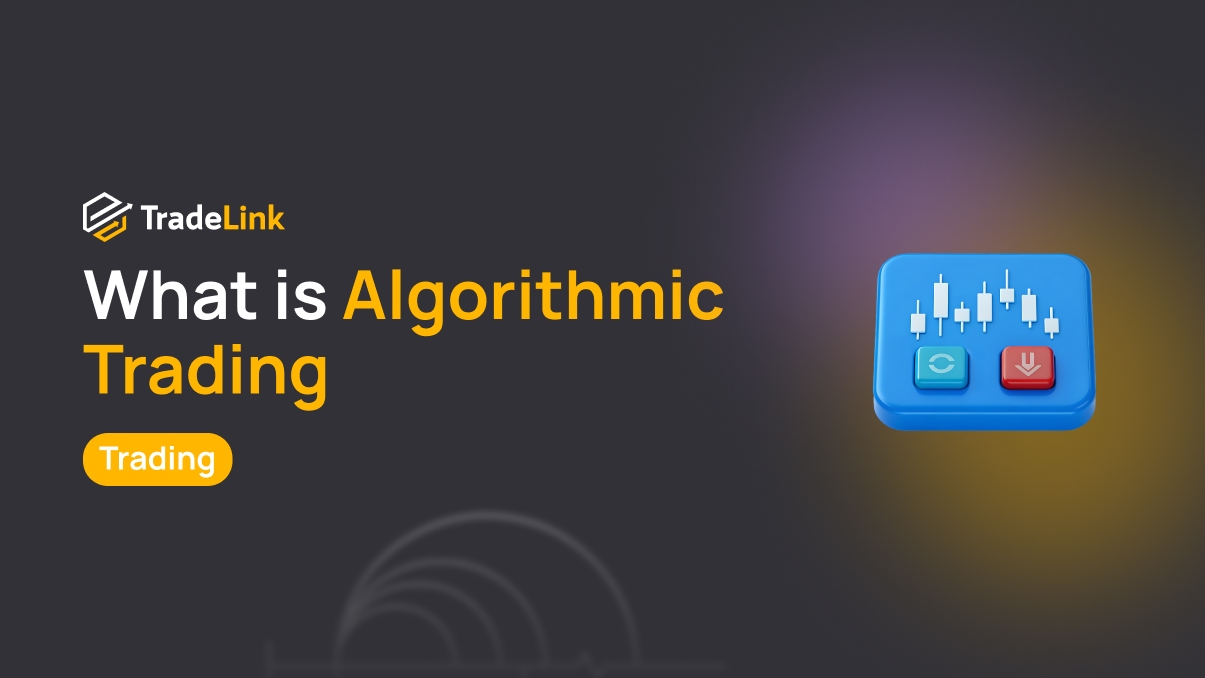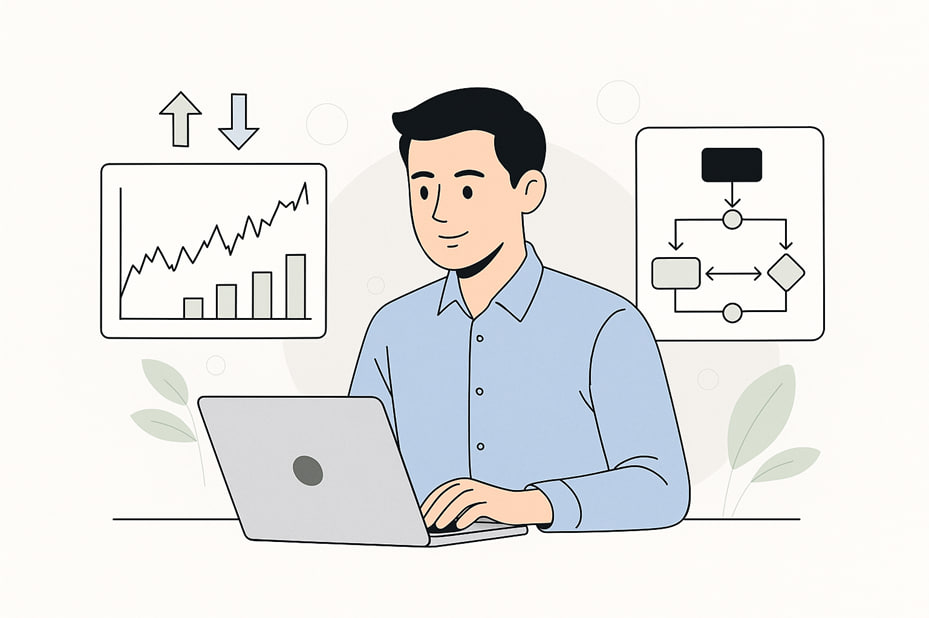Algorithmic Trading Explained: How It Works and Why It Matters

Contents
- Introduction
- What is Algorithmic Trading
- Algorithmic Trading in the Cryptocurrency Market
- Simple Strategies for Beginners
- Advantages and Risks of Algorithmic Trading
- How to Get Started with Algorithmic Trading
- Conclusion
Introduction
Algorithmic trading is no longer a tool reserved only for major players. In the past, it was primarily used by hedge funds and investment banks, but today it is accessible to anyone. This has been made possible by open APIs on crypto exchanges, the proliferation of trading bots, and the overall growth of interest in automation.
In the context of market instability and constant information noise, it becomes increasingly complex for traders to make decisions manually. Algorithms help speed up the process and reduce the influence of emotions. As a result, they have gained popularity among retail investors as well.
This article explains algorithmic trading, how it works, and why it is useful. It will help you understand how to use the technology effectively and avoid common mistakes.
What is Algorithmic Trading

Algorithmic trading is a method of automatically executing trades based on predefined rules. Instead of manually opening and closing positions, the trader sets specific conditions that the algorithm follows. These rules are written in code or configured through specialized platforms.
The program receives market data and monitors for the conditions to be met. When the right situation occurs, it sends a command to buy, sell, or take another action. Everything happens automatically, without human intervention, and much faster than it could be done manually.
The key to algorithmic trading is clear logic. There is no place for intuition, guesswork, or emotion. The algorithm follows the defined strategy and does not deviate from it.
How Algorithmic Trading Works
Every trading algorithm follows the same cycle: receive data, process, and execute. First, the program retrieves information from the exchange. This may include the asset’s price, trading volume, chart changes, or indicator signals.
The algorithm then processes this data. For example, if the price exceeds the moving average, it might open a long position. Or, if the RSI indicates overbought conditions, the algorithm may sell the asset.
After analysis, the program sends an order to the exchange. It determines the entry and exit points and sets stop-loss and take-profit levels if these are part of the strategy.
All of this happens without constant human involvement. The trader only sets the parameters and monitors the results.
Where Algorithmic Trading is Used
Algorithmic trading is used in nearly all segments of the financial market.
-
It helps process large volumes of stock market orders. Major investors use algorithms to buy and sell shares with minimal market impact.
-
In Forex, algorithms are used to trade currency pairs. Programs track rate changes and respond instantly to fluctuations.
-
However, algorithmic trading is mainly active in the cryptocurrency market. Here, trading is 24/7, with no weekends or breaks. Manually monitoring such a market is challenging and exhausting. Algorithms take on that burden — they work nonstop, follow predefined logic, and respond to signals anytime.
Most crypto exchanges, such as Binance, Bybit and OKX, support algorithm integration via API. This allows traders to build their strategies or use existing solutions.
Algorithmic Trading in the Cryptocurrency Market

The crypto market is known for its high volatility—prices often move sharply and unpredictably. Algorithms allow traders to respond automatically to these movements, opening and closing trades instantly, even when the trader is asleep or away.
Algorithmic strategies are widely adopted in crypto trading. This is mainly because most major crypto exchanges offer open APIs—interfaces through which programs can receive price quotes, track order book changes, and send trading commands.
Algorithmic trading on crypto exchanges is popular among individual traders and large, capitalised teams.
However, it’s important to note that each exchange has its conditions: request rate limits, restrictions on specific operations, or mandatory identity verification. So, before launching an algorithm, it’s essential to study the technical documentation of the chosen platform.
Tools for Algorithmic Trading
You don’t need to be a programmer to start automated trading today. Many tools allow you to build strategies without writing any code.
One option is to use trading bots. These programs can be connected to an exchange and configured according to your rules. Users define the conditions for entering and exiting trades and acceptable risk levels through a visual interface. However, it’s essential to understand that behind the simplicity of the interface lies the need to formulate a strategy—without this, the bot will not operate effectively and could lead to losses.
Third-party services that support multiple exchanges exist, such as 3Commas, Cryptohopper, and TradeLink Marketplace. These platforms allow you to run strategies or connect algorithms via API. Each has its own approach. Some focus on visual tools, while others emphasise detailed statistics and indexes.
These solutions are suitable for both beginners and experienced traders. The key is understanding how the system works and testing the strategy before using it on a live account.
Simple Strategies for Beginners
Here are a few basic strategies that are time-tested and suitable for beginners.
-
One of the most common approaches is trading based on a moving average. This is a line that shows the average price over a specific period. If the price rises above the line, it may be a signal to buy. If it drops below, it will sell.
-
Another straightforward strategy is trend following. The algorithm identifies the market direction and opens trades, reducing risk and helping avoid sudden reversals.
-
You can also use signals from technical indicators. For example, RSI shows whether an asset is overbought. The stochastic oscillator helps determine the entry point.
None of these strategies requires deep knowledge. But it’s important to remember that errors in algorithm logic, incorrect parameters, or unexpected market behavior can lead to losses. That’s why it makes sense to test a strategy on a demo account or start with minimal volume before trading with real money—this helps avoid unexpected losses.
Advantages and Risks of Algorithmic Trading
Like any tool, algorithmic trading has its strengths and weaknesses. Below are the key advantages and disadvantages to consider before launching a strategy:
Pros | Cons |
Speed. The program reacts to signals instantly, without hesitation or delay. | Takes time to set up. You need to understand the strategy, key parameters, and how the market works. |
Precision. The algorithm strictly follows predefined rules, unaffected by emotions or human error. | Risk of malfunction. A coding error or exchange issue may lead to incorrect trades and losses. |
Scalability. An algorithm can operate on multiple exchanges and handle many instruments at once. | Overfitting risk. A strategy that performs well in backtesting might fail in real-time trading — thorough testing is essential. |
How to Get Started with Algorithmic Trading

You don’t need to be a programmer to begin. The most important thing is the willingness to learn and take it step by step.
The first step is to understand how exchanges and order types work. You need to know what market orders, limit orders, and stop orders are. Without this knowledge, it’s impossible to configure a strategy or control its execution properly.
Next, it is essential to chooseш a platform that supports automated trading via API. This could be a ready-made solution or custom code—what matters is access to the necessary tools and documentation.
Strategy choice depends on your goals and trading style. It’s unnecessary to start with something simple — you can begin with complex algorithms if you’re ready to study and test them thoroughly. The key is understanding the strategy’s logic and verifying it in a controlled environment.
You should also learn the basics of risk management. An algorithm can behave unpredictably if incorrect parameters are set. That’s why it’s essential to regularly monitor its behavior, test thoroughly, and control the risks.
Conclusion
Algorithmic trading helps traders act faster, more precisely, and with less emotional involvement. Instead of watching charts all day, it’s enough to configure a strategy and let the program handle the execution. The algorithm doesn’t get tired, distracted, or emotional — it just follows rules and gives traders more freedom.
However, automation does not eliminate responsibility. An algorithm is a tool, not a magic button. It only works if the trader understands what they’re doing. Strategies must be tested, the market must be monitored, and the approach must be adapted if conditions change.